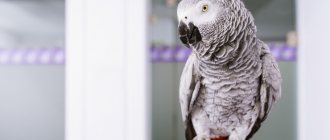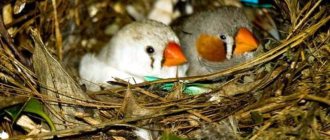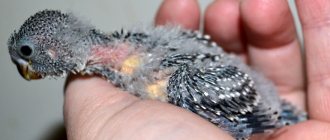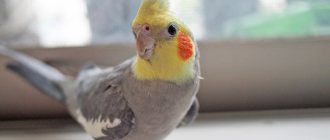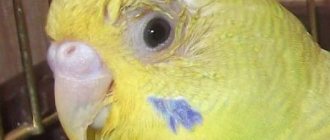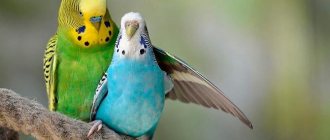Budgerigars are beautiful, sociable and cheerful birds, so if you tame them from a young age, they will spend all their time next to a person. But if the owner is away from home for a long time, then it is advisable to purchase a pair for your pet.
If optimal conditions are created, the birds begin the mating season, which leads to mating, egg-laying and the appearance of offspring. If a person is interested in starting the mating season for budgerigars, it is necessary to choose the parrots wisely, purchase a nest, maintain the necessary conditions in the room, and also perform other mandatory actions.
Mating season
Most often, females accept courtship from older partners. Males begin to conquer only when they have acquired a cozy nest. This should be understood if you want to know how long to wait for the first eggs.
How to understand that a male is ready for a family
During the mating season, the male takes the initiative. To understand that he is ready for family life, watch him. The feathered one will devote all his strength and time (no matter how much is required) to conquering his chosen one.
The parrot chirps, playfully taps its beak, jumps around, feeds the female, and presents a variety of gifts. Why is he doing this? Draws attention to itself.
Demonstrating readiness for motherhood
The fact that the female is ready for motherhood is signaled by the brown color of the small skin growth on the beak. When the chosen one is ready, she will accept courtship. After watching the video, you can see how the formed couple behaves.
The female will begin to tuck her wings and raise her tail feathers, fluffing out the feathers on her head, a few days after courtship begins.
How does mating happen?
Feathered pets do not have external genitalia. Reproduction of budgerigars occurs due to the contact of cloaca.
Females have an ovary and an oviduct, which opens into the cloaca. Males have several testes with canals, which also exit into the cloaca. Feathered pets reproduce as follows: the pair is positioned so that the female is on the bottom. The male will need to press closer to the area under the tail.
During reproduction, mating occurs repeatedly. The process of creating a family can begin a few days after hanging the nesting house. Sometimes situations occur when a couple that has already been formed for a long time begins to reproduce without waiting for construction.
When does mating season begin for budgerigars?
The mating season for parrots begins at 4-5 months, the ability to reproduce appears at 5-7 months, but full maturity occurs only at 1-1.5 years. It is important to know that weak and thin birds have much less chance of raising healthy offspring, unlike their moderately well-fed relatives. When preparing for reproduction, age should not be neglected, since a female that is too young may not be able to survive the first laying of eggs. Fecundity lasts up to 8-9 years, but its peak occurs in the 2-4th year of a bird’s life. If the necessary conditions are maintained, parrots can remain fertile even at an older age than 8-9 years.
When mating occurs
Usually the birth of chicks occurs in the summer. During this period, parrots are provided with everything they need (sunlight, vitamins, comfortable temperature conditions).
In autumn and winter, it is also possible to bring parrots together and introduce them to each other. Extend daylight hours using artificial lighting to 16 hours. Make sure the room temperature is 20 degrees. Parrots need a complete, fortified diet so that the birth of chicks is not accompanied by any problems.
Optimal conditions
If the owner of the wavy is interested in breeding birds, then before the start of the mating season it is necessary to create optimal conditions. Birds will not mate if they are worried, cold or stressed.
The main conditions include:
Mutual sympathy between wavy animals .
The mating season begins exclusively between birds who have positive feelings for each other. This is quite rare, since often the birds simply fight or are indifferent to the presence of the second wavy. Therefore, sometimes it is necessary to place several females in a male’s cage until a suitable pair is found. If the birds feel sympathy, then the male begins to court the girl.- Installing a socket .
It is designed for oviposition. The female must get used to this element, and also prepare it herself using sawdust or twigs. It is advisable to choose a house whose size exceeds 25x25x15 cm, and the diameter of the entrance should exceed 4 cm. A small depression is made in the center to prevent the eggs from rolling out. You can make a small hole on top to be able to observe the hatched chicks. Just below the entrance, a perch is made, on which the male, caring for the couple, prefers to sit. - Adjusting your diet . From the beginning of the mating season, it is necessary to slightly change the bird’s diet. They need to be given protein foods and also have mineral stones attached to the cell walls. The female needs additional vitamins and microelements, which allow her to form and hatch eggs without harm to the body. Therefore, the diet includes porridge with water, sprouted grains, low-fat cottage cheese, eggshells, mineral stone and a boiled chicken egg.
- Season. Experienced breeders recommend that beginners breed chicks in the summer. During this period of time, the birds receive a lot of sunlight, and high-quality feeding with fresh fruits and vegetables is also provided.
- Calm environment. The mating period begins only in wavy birds that do not experience stress. This ensures a calm and pleasant environment. It is not recommended to have new pets, invite people unfamiliar to the birds home, listen to music or TV loudly, or turn on artificial light suddenly at night.
It is impossible to breed wavy animals who suffer from exhaustion or obesity, and also have hereditary diseases or family ties with the couple.
Did your parrots have chicks?
Not really
The appearance of chicks
During breeding, the female begins to lay eggs once a day. How many days will it take to wait until the offspring appear? After 2-3 weeks of hanging in the cage of the nesting house, eggs will begin to appear.
The bird usually does not hatch its offspring immediately. This happens only after 2 eggs have appeared in the nest. The female warms them with her body, incubates them, and at this time the male feeds her.
How many chicks should I wait? Wavys usually have 5 eggs. Small chicks hatch after 17 days. If the eggs lie for more than 21 days, it means they are not fertilized or the embryos have died.
Pregnant bird or not?
How do you know if a female is pregnant? If mating is successful, she will become more tense and aggressive after a few days. The female will stop eating on her own. The male will take care of her.
In addition, she will begin to pull out feathers near the cloaca. A change in the nature of the litter will also indicate that the bird is pregnant. The owner of parrots will be able to easily notice when the bird is ready to lay an egg: after a few days, the area next to the cloaca will noticeably swell.
Creating a nest
The birth of offspring in parrots is possible only when a nest is built. What should you consider when building a house?
Dimensions can be 17x25x17. In appearance it may resemble a birdhouse. It must be fixed from the outside of the cage. To build a house, use planks, not plywood.
Place a 4-5 cm taphole closer to the top of the house. Make a hole in the middle of the bottom and put sawdust there. Due to this, the eggs (no matter how many there are) will not roll out. Add dry chamomile to the sawdust for disinfection. The house needs to be equipped with a perch.
Do not move the cage while nesting. By doing this you will harm the parrots and scare them. This way you can reduce all your efforts to nothing.
How does the process work?
First comes the mating season, when the birds coo and flirt with each other all the time.
To do this, the male performs the following actions:
- cleans the girl's feathers;
- feeds her from his beak;
- dances and sings;
- shows off by spreading its wings or raising its crest.
This period is very exciting to watch, as birds lose interest in humans and surrounding objects, paying attention only to each other. If a girl reacts positively to the male’s advances, then she herself begins to clean his feathers or bend her neck a little. Only after this period does the mating process begin.
Preparation
It is advisable to choose birds over two years old for mating. Sexual activity in wavy fish remains up to 9 years.
First, the preparatory stage begins, during which the following actions are performed:
the nest is being prepared;- diet changes;
- if the process occurs in winter or cloudy times, it is recommended to purchase a special lamp that allows the wavy plants to bask and also receive the required amount of ultraviolet radiation;
- the optimal duration of daylight hours is ensured, which is 16 hours a day;
- Twigs and sawdust are placed in the cage, which are used by the female to create a bed.
If you perform all the steps correctly, you are guaranteed to get strong and healthy offspring. During the mating period, it is not recommended to disturb the birds, so the learning process is suspended, but the wavy birds still need daily flight.
When mating occurs
It begins only when there is a nest and other suitable conditions. During the mating season, the female gradually gets used to the house, so at first she timidly looks in, and then begins to prepare the bed.
A few days after mating, its belly becomes rounded, and the number of feathers that the bird pulls out to make a nest decreases. About 10 days after mating, the female lays her first egg. Then she lays a few more eggs, after which she begins to hatch them. At this time, the bird rarely flies out of the nest, so the male takes care of it, bringing food.
You cannot clean or open the nesting house, as this is perceived negatively by the female, so she may abandon the eggs, so the embryos will die.
In the room where the birds are located, the optimal temperature is maintained, and drafts are not allowed. If you need to ventilate the room, the procedure is performed for 5 minutes, and during this time the cage is covered with thick fabric. 20 days after the first egg appears, the chicks begin to hatch. This leads to the appearance of a squeak, and a person can also look into the nest through a previously made hole.
If one egg does not hatch, then it must be removed so that the bird does not waste effort on hatching it. The same actions are performed with dead chicks. The procedure is performed carefully so as not to disturb the rest of the chicks.
As soon as all the chicks leave the nest, the house is removed so that the adult wavy birds do not begin to mate again. The process can be repeated only after six months, since during this period of time the female recovers and gains strength.
Bird behavior
It is easy to determine this period, since the behavior of the wavy radically changes.
Characteristic features include:
- the male takes care of the bird;
- the birds are cooing;
- the female begins to equip the nesting house, for which she brings into it twigs, sawdust and other small objects that are used to form the litter.
Parrots behave this way before the first egg appears, and after laying the female spends all her time in the nest. The male continues to care for her, for which he brings food in his beak, and also coos with the couple.
If the chicks were born at the end of summer, then it is advisable to allow the parents to recover until spring, after which they can again prepare for the birth of new offspring.
Is it possible to leave birds in the same cage?
Reproduction requires specific conditions, in the absence of which birds will not reproduce. Therefore, it is advisable to leave the birds in the same cage so that they do not get bored or sad. If the owner does not want to hatch any more chicks, then simply do not leave the nest inside the cage.
But if you leave the birds in one cage without cleaning the house, this will lead to rapid re-mating. The female will not be able to recover, so she may die.
Reasons why mating is impossible
Why is mating not always possible? It is worth considering some reasons that make the birth of offspring impossible:
- In the cage there are constantly quarrels between the parrots. This is a sure sign that the couple did not materialize. It will not be possible to bring parrots together, since sympathy between them will not arise even after a year.
- There are no quarrels, but the birds do not contact each other, they exist in parallel. This may indicate that the parrots are still young to breed.
- Why don't parrots mate? Perhaps they are of the same gender. Naturally, it will not be possible to bring them together in such a situation.
- Eggs from parrots are out of the question when they are immature or “retired.”
- Eggs may not be fertilized if the male or female is old.
It should be understood that the question of why birds do not start laying eggs at home is quite complex. And if the couple does not have offspring, it is recommended to contact an ornithologist. He will give advice and help you understand the true reasons, no matter how many there are.
The singing style of budgies
Let's try to figure out what budgies want to “tell” us in various cases:
- Tonality of sounds.
- What time do they sing?
- Characteristics of singing and gestures of budgerigars.
2.1. Tonality of sounds
By changing the tone of its sounds, a parrot can warn about its poor health, a feeling of hunger, or a desire to stretch its wings by flying around the room. In addition, in the same way, a bird can express its attitude to what is happening - delight, anxiety or indignation. Of course, learning to determine the mood of your pets by the tonality of the sounds they produce is not easy, however, with due desire and diligence, it is quite possible.
The tendency to sing develops in budgerigars by 3–6 months. Being very observant birds, they remember previously heard sounds in order to one day supplement their usual chirps and trills with skillfully parodied voices. Over time, their repertoire expands, it includes sounds of turned on household appliances, imitation of the voices of pets and humans.
With some effort, your pets can be trained to pronounce entire phrases , which they will pronounce not only out of curiosity, but also to express their needs.
2.2. What time do they sing
It is important to be aware of when budgies begin their displays and how long they last. Every day, continuous singing coming from the cage signals that the bird is healthy and happy with life.
Budgerigars enter the mating season after a year from birth, although they begin to become interested in the opposite sex a little earlier, by 6–7 months. Around this time, the “teenagers”, wanting to attract the attention of the female, begin to sing, performing their still quiet, extended trills, often not very successful, in a voice that is not yet strong.
A few months later, having grown stronger and matured, the males already give long, euphonious concerts for their potential “brides.” If the gentleman's advances are accepted, the singing becomes quieter and more melodic, but does not stop even during eating, when the male, trying to feed his girlfriend and offering her the most delicious morsels, incessantly coos contentedly.
In budgerigars, singing is the prerogative of the male; females only respond to them with quiet chirping, if the company is pleasant to them. From their “conversations,” the owner can understand that the birds are not complaining about their health and that a replenishment can be expected .
It is important to know that the frequent thoughtfulness of an adult parrot, his singing, accompanied by the concentration of his gaze on one point, indicates that he is lonely, and there is a need for an urgent selection of a mate .
2.3. Characteristics of singing and gestures of budgerigars
The characteristics of budgerigars' singing and their gestures can tell a lot about their condition, mood, and emotions. alarming notes in birdsong. Let's look at the main differences between the sounds and gestures of birds in order to determine their mood and needs:
- Quiet cooing indicates that the bird is happy and feeling well. If a parrot chirps periodically, it means that he is not averse to getting some kind of “yummy”. As a rule, such a change in tone in parrots indicates a desire to eat, or they simply do not have enough attention.
- Actually, singing. It is common for poultry to fill their leisure time with singing. Budgerigars can insert into their trill sounds they have overheard previously. Such concerts can last for several hours.
- Short "quack". Thus, the parrot wants to attract the owner’s attention to his person. When more than one bird lives in the house, it may be a desire to communicate with its relatives.
- Continuously repeated “quack.” The bird is unhappy with something. As a rule, these emotions are accompanied by throwing around the cage and flapping their wings. The reasons for dissatisfaction can be different: trying to touch with your hands, feeding against desire, etc.
- Sharp, loud screams. The parrot clearly doesn't like something. This is how newly acquired birds often behave, not yet accustomed to their new home. After a few weeks, the pet will change its anger to mercy, which will be reflected in the sounds it makes.
- A long silence, accompanied by the flapping of wings. Your pet's indignation simply leaves him speechless; he refuses to even sing. Try to calm him down by talking to him and feeding him tasty, favorite food.
- The parrot behaves quietly, closing its eyes halfway. There is no need to be scared, the bird is just tired and wants to sleep. There is no need to try to cheer her up, it is better to simply darken the room: turn off or dim the lights, cover the cage.
Video "Parrot Breeding"
The video talks in detail about how to breed parrots at home.
Sorry, there are no surveys available at this time.
Was this article helpful?
Thank you for your opinion!
The article was useful. Please share the information with your friends.
Yes (100.00%)
No
X
Please write what is wrong and leave recommendations on the article
Cancel reply
Rate the benefit of the article: Rate the author ( 3 votes, average: 5.00 out of 5)
Discuss the article:
